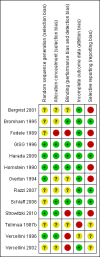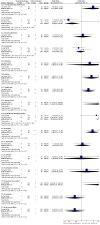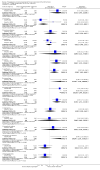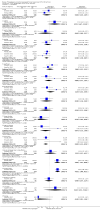Progestagens and anti-progestagens for pain associated with endometriosis
- PMID: 22419284
- PMCID: PMC6885053
- DOI: 10.1002/14651858.CD002122.pub2
Progestagens and anti-progestagens for pain associated with endometriosis
Abstract
Background: Endometriosis is a chronic inflammatory condition defined by the presence of glands and stroma outside the uterine cavity. It occurs in 7% to 10% of all women of reproductive age and may present as pain or infertility. The pelvic pain may be in the form of dysmenorrhoea, dyspareunia or pelvic pain. Initially a combination of estrogens and progestagens was used to create a pseudopregnancy and alleviate the symptoms associated with endometriosis. Progestagens alone or anti-progestagens have been considered as alternatives because they are inexpensive and may have a better side effect profile than other choices.
Objectives: To determine the effectiveness of both the progestagens and anti-progestagens in the treatment of painful symptoms ascribed to the diagnosis of endometriosis.
Search methods: We used the search strategy of the Menstrual Disorders and Subfertility Group to identify all publications which described or might have described randomised controlled trials (RCTs) of any progestagen or any anti-progestagen in the treatment of symptomatic endometriosis. We updated the review in 2011.
Selection criteria: We considered only RCTs which compared the use of progestagens and anti-progestagens with other interventions, placebo or no treatment for the alleviation of symptomatic endometriosis.
Data collection and analysis: We have added six new studies, bringing the total of included studies to 13 in the update of this review. The six newly included studies evaluated progestagens (comparisons with placebo, danazol, oral or subdermal contraceptive, oral contraceptive pill and danazol, gonadotrophin-releasing hormone (GnRH) analogue and other drugs). The remaining studies compared the anti-progestagen gestrinone with danazol, GnRH analogues or itself.
Main results: The progestagen medroxyprogesterone acetate (100 mg daily) appeared to be more effective at reducing all symptoms up to 12 months of follow-up (MD -0.70, 95% CI -8.61 to -5.39; P < 0.00001) compared with placebo. There was evidence of significantly more cases of acne (six versus one) and oedema (11 versus one) in the medroxyprogesterone acetate group compared with placebo. There was no evidence of a difference in objective efficacy between dydrogesterone and placebo.There was no evidence of a benefit with depot administration of progestagens versus other treatments (low dose oral contraceptive or leuprolide acetate) for reduced symptoms. The depot progestagen group experienced significantly more adverse effects.There was no overall evidence of a benefit of oral progestagens over other medical treatment at six months of follow-up for self-reported efficacy. Amenorrhoea and bleeding were more frequently reported in the progestagen group compared with other treatment groups.There was no evidence of a benefit of anti-progestagens (gestrinone) compared with danazol. GnRH analogue (leuprorelin) was found to significantly improve dysmenorrhoea compared with gestrinone (MD 0.82, 95% CI 0.15 to 1.49; P = 0.02) although it was also associated with increased hot flushes (OR 0.20, 95% CI 0.06 to -0.63; P = 0.006).
Authors' conclusions: There is only limited evidence to support the use of progestagens and anti-progestagens for pain associated with endometriosis.
Conflict of interest statement
AJD was partly employed on a non‐conditional educational grant from Zeneca Pharma. The grant was utilised to provide a telephone support line for endometriosis patients attending a tertiary specialist clinic.
Figures








































Update of
-
Progestagens and anti-progestagens for pain associated with endometriosis.Cochrane Database Syst Rev. 2000;(2):CD002122. doi: 10.1002/14651858.CD002122. Cochrane Database Syst Rev. 2000. Update in: Cochrane Database Syst Rev. 2012 Mar 14;(3):CD002122. doi: 10.1002/14651858.CD002122.pub2. PMID: 10796864 Updated.
References
References to studies included in this review
Bergvist 2001 {published data only}
-
- Bergqvist A, Thorell T. Changes in quality of life after hormonal treatment for endometriosis. Acta Obstetricia et Gynecologica Scandinavica 2001;80:628‐37. - PubMed
Bromham 1995 {published and unpublished data}
-
- Bromham DR, Booker MW, Rose GL, Wardle PG, Newton JR. A multicentre comparative study of gestrinone and danazol in the treatment of endometriosis. Journal of Obstetrics and Gynaecology 1995;15:188‐94.
-
- Bromham DR, Booker MW, Rose GL, Wardle PG, Newton JR. Updating the clinical experience in endometriosis ‐ the European perspective. British Journal of Obstetrics and Gynaecology 1995;102 Suppl 12:12‐6. - PubMed
Fedele 1989 {published data only}
-
- Fedele L, Arcaini L, Bianchi S, Viezzoli T, Arcaini L, Candiani GB. Gestrinone versus danazol in the treatment of endometriosis. Fertility and Sterility 1989;51(5):781‐5. - PubMed
-
- Fedele L, Bianchi S, Marchini M, Nola G. Histological impact of medical therapy‐clinical implications. British Journal of Obstetrics and Gynaecology 1995;102 Suppl 12:8‐11. - PubMed
GISG 1996 {published data only}
-
- The Gestrinone Italian Study Group. Gestrinone versus a gonadotropin releasing hormone agonist for the treatment of pelvic pain associated with endometriosis: a multicenter, randomised, double‐blind study. Fertility and Sterility 1996;66:911‐9. - PubMed
Harada 2009 {published data only}
-
- Harada T, Momoeda M, Taketani Y, Takeshi A, Fukunaga M, Hagino H, et al. Dienogest is as effective as intranasal buserelin acetate for the relief of pain symptoms associated with endometriosis ‐ a randomized, double blind, multi‐centre trial. Fertility and Sterility 2009;91(3):675‐81. - PubMed
Hornstein 1990 {published data only}
-
- Hornstein MD, Glaeson RE, Barbieri RL. A randomised, double‐blind prospective trial of two doses of gestrinone in the treatment of endometriosis. Fertility and Sterility 1990;53(2):237‐41. - PubMed
Overton 1994 {published data only}
-
- Overton CE, Lindsay PC, Johal B. A randomised, double‐blind, placebo controlled study of luteal phase dydrogesterone (Duphaston) in women with minimal to mild endometriosis. Fertility and Sterility 1994;62(4):701‐7. - PubMed
Razzi 2007 {published data only}
-
- Razzi S, Luisi S, Ferretti C, Calonaci F, Gabbanini M, Mazzini M, et al. Use of progestogen only preparation containing desogestrel in the treatment of recurrent pelvic pain after conservative surgery for endometriosis. European Journal of Obstetrics and Gynecology 2007;135:188‐90. - PubMed
Schlaff 2006 {published data only}
-
- Sclaff W, Carson S, Luciano A, Ross D, Bergvist A. Subcutaneous injection of depot medoxyprogesterone acetate compared with leuprolide acetate in the treatment of endometriosis associated pain. Fertility and Sterility 2006;85(2):314‐25. - PubMed
Strowitzki 2010 {published data only}
-
- Strowitzki T, Marr J, Gerlinger C, Faustmann T, Seitz C. Dienogest is as effective as leuprolide acetate in treating the painful symptoms of endometriosis: a 24 week, randomized, multicentre, open‐label trial. Human Reproduction 2010;25(3):633‐41. - PubMed
Telimaa 1987b {published and unpublished data}
-
- Kauppila A, Telimaa S, Ronnberg L, Vuori J. Placebo controlled study on serum concentrations of CA‐125 before and after treatment of endometriosis with danazol or high‐dose medroxyprogesterone acetate alone or after surgery. Fertility and Sterility 1988;49(1):37‐41. - PubMed
-
- Telimaa S. Danazol and medroxyprogesterone acetate inefficacious in the treatment of infertility in endometriosis. Fertility and Sterility 1988;50(6):872‐5. - PubMed
-
- Telimaa S, Poulakka J, Ronnberg L, Kauppila A. Placebo controlled comparison of danazol and high‐dose medroxyprogesterone acetate in the treatment of endometriosis. Gynecological Endocrinology 1987;1:13‐23. - PubMed
Vercellini 1996 {published data only}
-
- Vercellini P, Giorgi O, Oldani S, Cortesi I, Panazza S, Crosignani PG. Depot medroxyprogesterone acetate versus an oral contraceptive combined with very‐low‐dose danazol for long‐term treatment of pelvic pain associated with endometriosis. American Journal of Obstetrics and Gynecology 1996;175:396‐401. - PubMed
Vercellini 2002 {published data only}
-
- Vercellini P, Giorgi O, Mosconi P, Stellato G, Vicentini S, Crosignani P. Cytoproterone acetate versus a continuous monophasic oral contraceptive in the treatment of recurrent pelvic pain after conservative surgery for symptomatic endometriosis. American Journal of Obstetrics and Gynecology 2002;77(1):52‐61. - PubMed
References to studies excluded from this review
Cosson 2002 {published data only}
-
- Cosson M, Querleu D, Donnez J, Madelenat P, Koninckx P, Audebert A, et al. Dienogest is as effective as triptorelin in the treatment of endometriosis after laparoscopic surgery: results of a prospective, multicenter, randomized study. Fertility and Sterility 2002;77(4):684‐92. - PubMed
Dawood 1997 {published data only}
-
- Dawood MY, Obasiolu CW, Ramos J, Khan‐Dawood FS. Clinical, endocrine and metabolic effects of two doses of gestrinone in treatment of pelvic endometriosis. American Journal of Obstetrics and Gynecology 1997;176:387‐94. - PubMed
Harrison 2000 {published data only}
-
- Harrison R, Barry‐Kinsella C. Efficacy of medroxyprogesterone treatment in infertile women with endometriosis: a prospective, randomized, placebo‐controlled trial. Fertility and Sterility 2000;74(1):24‐30. - PubMed
Mettler 1987 {published data only}
-
- Mettler L, Semm K. Three‐step therapy of genital endometriosis in cases of human infertility with lynestrenol, danazol or gestrinone administration in the second step. In: JP Raynaud editor(s). Medical Management of Endometriosis. New York: Raven Press, 1984:233‐47.
Nieto 1996 {published data only}
-
- Nieto A, Tacuri C, Serra M, Keller J, Cortes‐Prieto J. Long term follow‐up of endometriosis after two different therapies (gestrinone and buserelin). Clinical & Experimental Obstetrics and Gynecology 1996;23(4):199‐203. - PubMed
Noble 1980 {published data only}
Regidor 2001 {published data only}
-
- Regidor P, Regidor M, Schmidt M, Ruwe B, Lubben Fortig P, Kienle E, et al. Prospective randomized study comparing the GnRH‐agonist leuprorelin acetate and gestagen lyestrenol in the treatment of severe endometriosis. Gynecological Endocrinology 2001;15:202‐9. - PubMed
Strowitzki 2009 {published data only}
-
- Strowitzki T, Seitz C, Marr J, Gerlinger C, Faustmann T. Efficacy of dienogest for the treatment of endometriosis: a 24 week, randomised, open label trial versus leuprolide acetate. Human Reproduction. 2009; Vol. 24 Suppl 1. - PubMed
Telimaa 1987a {published data only}
-
- Telimaa S, Kauppila A, Ronnberg L, Suikkari AM, Seppala M. Elevated serum levels of endometrial secretory protein PP14 in patients with advanced endometriosis. American Journal of Obstetrics and Gynecology 1989;161:866‐71. - PubMed
-
- Telimaa S, Penttila I, Puolakka J, Ronnberg L, Kauppila A. Circulating lipid and lipoprotein concentrations during danazol and high‐dose medroxyprogesterone acetate therapy of endometriosis. Fertility and Sterility 1989;52(1):31‐5. - PubMed
Thomas 1987a {published data only}
Vercellini 2005 {published data only}
-
- Vercellini P, Pietropaolo G, Giogi O, Pasin R, Chiodini A, Crosignani P. Treatment of symptomatic rectovaginal endometriosis with an estrogen‐progestogen combination versus low dose norethindrone acetate. Fertility and Sterility 2005;84(5):1375‐87. - PubMed
Walch 2009 {published data only}
-
- Walch K, Unfried G, Huber J, Kurz C, Trotsenburg M, Pernicka E, et al. Implanon versus medoxyprogesterone acetate: effects on pain scores in patients with symptomatic endometriosis ‐ a pilot study. Contraception 2009;79:29‐34. - PubMed
Worthington 1993 {published data only}
-
- Worthington M, Irvine LM, Crook D. A randomised comparative study of the metabolic effects of two regimens of gestrinone in the treatment of endometriosis. Fertility and Sterility 1993;59(3):522‐6. - PubMed
Yang 2006 {published data only}
-
- Yang D, Ma W, Qu F, Ma B. Comparative study of Yiweining and gestrinone for post‐operational treatment of stage 3 endometriosis. Chinese Journal of Integrative Medicine 2006;12(3):218‐20. - PubMed
Additional references
Augoulea 2008
-
- Augoulea A, Lambrinoudaki I, Christodoulakos G. Thoracic endometriosis syndrome. Respiration 2008;75(1):113‐9. - PubMed
Barlow 1993
-
- Barlow DH, Glynn CJ. Endometriosis and pelvic pain. Clinical Obstetrics and Gynaecology 1993;7(4):775‐89. - PubMed
Davis 2007
Haney 1993
-
- Haney AF. Endometriosis‐associated infertility. Baillieres Clinical Obstetrics and Gynaecology 1993;7(4):791‐12. - PubMed
Kistner 1958
-
- Kistner RW. The use of newer progestins in the treatment of endometriosis. American Journal of Obstetrics and Gynecology 1958;75:264‐78. - PubMed
Kistner 1959
-
- Kistner RW. Treatment of endometriosis by inducing pseudo‐pregnancy with ovarian hormones. Fertility and Sterility 1959;10:539‐54.
Kruitwagen 1993
-
- Kruitwagen RF. Menstruation as the pelvic aggressor. Baillieres Clinical Obstetrics and Gynaecology 1993;7(4):687‐700. - PubMed
Lancaster 1995
-
- Lancaster JM, Prentice A, Smith SK. Successful medical treatment of sub‐diagphragmatic endometriosis. Journal of Obstetrics and Gynaecology 1995;15:206‐9.
Mathias 1996
-
- Mathias SD, Kupperman M, Liberman RF, Lipschutz RC, Steege JF. Chronic pelvic pain: prevalence, health related quality of life, and economic correlates. Obstetrics and Gynaecology 1996;87:321‐7. - PubMed
McLaren 1996
-
- McLaren J, Prentice A. New aspects of pathogenesis of endometriosis. Current Obstetrics and Gynaecology 1996;6:85‐91.
Moghissi 1990
-
- Moghissi KS. Pseudopregnancy induced by estrogen‐progestagen or progestagens alone in the treatment of endometriosis. Progress in Clinical and Biological Research 1990;323:221‐32. - PubMed
Prentice 1996
-
- Prentice A, Ingamells S. Endometriosis and Infertility. Journal of the British Fertility Society 1996;1:51‐5.
Rodgers 2008
-
- Rodgers AK, Falcone T. Treatment strategies for endometriosis. Expert Opinion on Pharmacotherapy 2008;9(2):243‐55. - PubMed
Spitz 2003
-
- Spitz IM. Progesterone antagonists and progesterone receptor modulators: an overview. Steroids 2003;68(10‐13):981‐93. - PubMed
Wheeler 1989
-
- Wheeler JM. Epidemiology of endometriosis‐associated infertility. Journal of Reproductive Medicine 1989;34(1):41‐6. - PubMed
Publication types
MeSH terms
Substances
LinkOut - more resources
Full Text Sources
Medical

